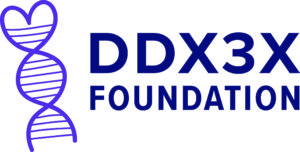
In addition to progressive changes in the white matter / myelin of her brain, Clara’s genetics show she has a mutation within the DDX3X gene.
DDX3X Syndrome is an extremely rare genetic syndrome. Approximately 500 people in the world are known to have a variation in their DDX3X gene. But, as DDX3X Syndrome was only first discovered and written about a handful of years ago, it’s hard to pinpoint the frequency of occurrence.
DDX3X Sybdrome is not known to be progressive, but produces moderate to profound developmental disabilities. Seizures and sensorineural hearing loss are common amongst those with DDX3X Syndrome, and it is associated with certain abnormalities in the brain such as issues related to the temporal horn and disorders of the corpus callosum. DDX3X is not associated with progressive changes to the white matter / myelin of the brain, such as the type that Clara has, which means her DDX3X Syndrome has occurred concurrently with the progressive white matter disorder of her brain.
DDX3X Syndrome patients have a wide spectrum of affects. Some learn to run and jump while others never master walking. Many are non-verbal though some learn many words or signs.
Before the known existence of DDX3X Syndrome, it was often misdiagnosed as autism spectrum disorder, cerebral palsy, Rett Syndrome, Dandy Walker Syndrome, or a generic delayed label. DDX3X is linked to intellectual disabilities, seizures, autism, low muscle tone, abnormalities of the brain, and slower physical developments. You can learn more at the DDX3X Foundation and this excellent summary, DDX3X-syndrome-_Unique.
Research is ongoing to help science understand and potentially find a cure for DDX3X Syndrome. The DDX3X Foundation was formed to lead the charge in those efforts.

